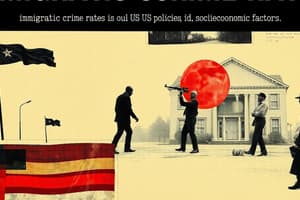Podcast
Questions and Answers
What was one policy change made by Canada's Trudeau government regarding family migration in 2019?
What was one policy change made by Canada's Trudeau government regarding family migration in 2019?
- Increased the number of skilled workers
- Eliminated family class immigration
- Raised the dependent age limit (correct)
- Limited the arrival of grandparents
Under neoliberalism, immigrants are often viewed as what?
Under neoliberalism, immigrants are often viewed as what?
- Managers of market stability
- Sources of cultural enrichment
- Essential contributors to the economy
- Threats to national security (correct)
Which category does NOT belong to Canada's immigration system?
Which category does NOT belong to Canada's immigration system?
- Employment Class (correct)
- Family Class
- Business Class
- Refugee and Humanitarian Class
What is the minimum passing score typically set for the Point System in Canada's economic class immigration?
What is the minimum passing score typically set for the Point System in Canada's economic class immigration?
What is a factor for earning additional points in Canada’s Point System?
What is a factor for earning additional points in Canada’s Point System?
Which of the following is a persistent trend in immigration policies observed under recent governments?
Which of the following is a persistent trend in immigration policies observed under recent governments?
Which of the following best describes the trend in immigration policy regarding skilled immigrants?
Which of the following best describes the trend in immigration policy regarding skilled immigrants?
Which factor is NOT included in the core factors for Canada's Point System for economic immigration?
Which factor is NOT included in the core factors for Canada's Point System for economic immigration?
What was a significant factor that contributed to the establishment of Africville?
What was a significant factor that contributed to the establishment of Africville?
Which of the following best describes the main reason residents of Africville faced economic challenges?
Which of the following best describes the main reason residents of Africville faced economic challenges?
What was a key characteristic of the urban renewal program in the 1960s that affected Africville?
What was a key characteristic of the urban renewal program in the 1960s that affected Africville?
What type of legacy did Africville's history contribute to in terms of cultural memory?
What type of legacy did Africville's history contribute to in terms of cultural memory?
Which key aspect did the 1910 Immigration Act emphasize in its prohibitory powers?
Which key aspect did the 1910 Immigration Act emphasize in its prohibitory powers?
What is the primary characteristic that differentiates a refugee from an asylum seeker?
What is the primary characteristic that differentiates a refugee from an asylum seeker?
What is a key vulnerability of Internally Displaced Persons (IDPs)?
What is a key vulnerability of Internally Displaced Persons (IDPs)?
What was one major change introduced by the 1976 Immigration Act?
What was one major change introduced by the 1976 Immigration Act?
What did the Immigration and Refugee Protection Act of 2002 primarily focus on?
What did the Immigration and Refugee Protection Act of 2002 primarily focus on?
Which of the following best defines an irregular migrant?
Which of the following best defines an irregular migrant?
What is the ideal durable solution for refugees according to international guidelines?
What is the ideal durable solution for refugees according to international guidelines?
What was one recognized issue in the labor market for immigrants as reflected in the 2002 Immigration Act?
What was one recognized issue in the labor market for immigrants as reflected in the 2002 Immigration Act?
What is the primary focus of the Cartagena Declaration on refugees?
What is the primary focus of the Cartagena Declaration on refugees?
What is the least common durable solution for refugees according to international frameworks?
What is the least common durable solution for refugees according to international frameworks?
Which role does the UNHCR NOT play in relation to refugees?
Which role does the UNHCR NOT play in relation to refugees?
Which of the following options describes a common reason for irregular migration?
Which of the following options describes a common reason for irregular migration?
What is the primary aim of the Safe Third Country Agreement?
What is the primary aim of the Safe Third Country Agreement?
Which of the following does NOT represent an exception to the Safe Third Country Agreement?
Which of the following does NOT represent an exception to the Safe Third Country Agreement?
What is meant by 'downward assimilation' among second-generation immigrants?
What is meant by 'downward assimilation' among second-generation immigrants?
Which factor complicates the effectiveness of migration policies according to the content?
Which factor complicates the effectiveness of migration policies according to the content?
How do migrant networks influence migration flow?
How do migrant networks influence migration flow?
Which statement is true regarding the role of families and communities in migration decisions?
Which statement is true regarding the role of families and communities in migration decisions?
What is one reason why policies may fail to limit migration?
What is one reason why policies may fail to limit migration?
What aspect of migrants' behavior is highlighted as a challenge to migration policies?
What aspect of migrants' behavior is highlighted as a challenge to migration policies?
What is a primary indicator of positive integration among second-generation immigrants?
What is a primary indicator of positive integration among second-generation immigrants?
How do ghettos differ from ethnic enclaves?
How do ghettos differ from ethnic enclaves?
What misconception exists regarding immigration and crime rates?
What misconception exists regarding immigration and crime rates?
What is NOT a characteristic of neighborhoods with high levels of segregation?
What is NOT a characteristic of neighborhoods with high levels of segregation?
What major trend concerning refugees occurred between 2005 and 2019?
What major trend concerning refugees occurred between 2005 and 2019?
What common misconception about immigration and neighborhoods is often perpetuated?
What common misconception about immigration and neighborhoods is often perpetuated?
Which statement best reflects the relationship between immigration and crime statistics?
Which statement best reflects the relationship between immigration and crime statistics?
Which of the following statements is false regarding segregation among immigrant groups?
Which of the following statements is false regarding segregation among immigrant groups?
Flashcards are hidden until you start studying
Study Notes
Second-Generation Immigrants
- Second-generation immigrants, even from low-skilled backgrounds, generally achieve higher levels of education than their parents.
Myth 7: Mass Immigration Produces Mass Segregation
- Concerns about racial and ethnic segregation are present in Europe.
- There's no evidence that racial and ethnic segregation is increasing despite immigration.
- It's crucial to differentiate between ghettos and ethnic enclaves.
- Ghettos are areas predominantly inhabited by one ethnic or racial group due to exclusion and discrimination, leading to multigenerational poverty.
- Ethnic enclaves are racially mixed areas where different groups concentrate but still interact.
Myth 8: Immigration Sends Crime Rates Soaring
- There is no evidence that immigration increases crime.
- Many immigrant groups are overrepresented in crime statistics and prison populations, potentially due to factors like unemployment, income, and education.
- Studies show immigrants settle in areas with pre-existing higher crime rates, creating a misleading correlation.
- Immigrants often commit fewer crimes than native-born populations.
Global Trend 1: Growing Numbers of Refugees Worldwide
- The number of refugees worldwide doubled between 2005 and 2019.
- Canada's Trudeau government eased family migration by raising the dependent age limit and facilitating the arrival of grandparents.
Global Trend 5: The Criminalization of Immigrants under Neoliberalism
- Neoliberalism promotes market openness, conflicting with immigration criminalization.
- Policies like border control, detention, and deportation are common.
- Immigration and security policies in the West often fuel anti-immigrant attitudes.
- Governments face a dilemma between securing borders and maintaining global economic stability.
Canada's Immigration History
- Canada's immigration policy evolves over time.
- Main Immigration Categories:
- Economic Immigrants: Points System (evaluates age, education, language proficiency, work experience).
- Family Class: Immediate family members of Canadian citizens and permanent residents.
- Refugee and Humanitarian Class: Government-sponsored refugees, privately-sponsored refugees, mixed visas.
- Temporary Migrants: Students, guest workers, temporary labor.
The Point System for Economic Class Immigration in Canada
- Points are awarded for core factors like age, education, language proficiency, and work experience.
- Additional points are awarded for factors like a job offer, prior study or work experience in Canada, and family connections.
- A maximum of 100 points can be scored, with a minimum passing score typically set at 67 points.
Africville
- Historic Black community in Halifax, Nova Scotia, founded by formerly enslaved individuals and free Black people in the early 19th century.
- Residents faced systemic racism and economic challenges.
- Halifax's urban renewal program in the 1960s targeted Africville, deeming it "unsanitary" and leading to the forcible relocation of residents.
- The legacy of Africville highlights systemic barriers and the community's resilience.
1910 Immigration Act
- Empowered the Governor in Council to prohibit the landing of immigrants deemed unsuitable for Canada.
- Allowed for the exclusion of immigrants based on race, reflecting discriminatory attitudes of the time.
- Enabled selective immigration policies through class and occupation restrictions.
1976 Immigration Act
- Established immigration agreements with provinces and required an immigration plan.
- Focused on education, labor market experience, and introduced the business immigrant program.
- Allowed admissions based on humanitarian grounds.
- Created a unique private sponsorship program for refugees.
Immigration and Refugee Protection Act of 2002
- Replaced the 1976 Immigration Act.
- Increased focus on security and human capital.
- Insufficient recognition of immigrant skills and credentials in the labor market, resulting in declining employment success for immigrant cohorts.
International Refugee Law
- UNHCR defines refugees as people fleeing war, violence, or persecution crossing an international border for safety.
- Asylum seekers have crossed an international border seeking protection, but their claim for refugee status is yet to be determined.
- Internally Displaced Persons (IDPs) are displaced within their own country without crossing international borders.
- Irregular migrants enter a country without necessary legal documentation or authorization.
Role of UNHCR
- Documents refugees and organizes refugee camps and resettlement.
- Reports on conditions faced by refugees and advocates for the recognition of their rights.
- Provides services to refugees.
Durable Solutions
- Return to Country of Origin: Repatriation is ideal when conditions in the home country have improved for safe and dignified return.
- Local Integration: Integrating refugees into the host country is a viable option if conditions are favorable.
- Resettlement: Resettlement to a third country is the least common option.
International (UN) and Regional Refugee Conventions
- The Cartagena Declaration on refugees (1984) expanded the definition of refugees to include those fleeing violence and human rights violations.
- The Safe Third Country Agreement requires refugee claimants to seek protection in the first safe country they arrive in.
- The Agreement has increased irregular border crossings between the US and Canada.
Downward Assimilation
- Crime patterns among second-generation immigrants begin to resemble those of the native-born population.
- This phenomenon is particularly true for descendants of lower-skilled migrants, known as "downward assimilation".
- The notion of segmented assimilation suggests immigrants will inevitably assimilate, but the question is which segment of society they will assimilate into.
Why Migration Policies Fail
- Chain migration and networks make it difficult to control migrant flow.
- Family and community influence migration decisions.
- People at different stages of life migrate for varied reasons, which policies often overlook.
- The migration industry facilitates movement.
- Policies may inadvertently create migration opportunities.
- Migrants have agency and make decisions that defy policy.
- Economies reliant on remittances and emigration may resist policies aimed at limiting migration.
Studying That Suits You
Use AI to generate personalized quizzes and flashcards to suit your learning preferences.




